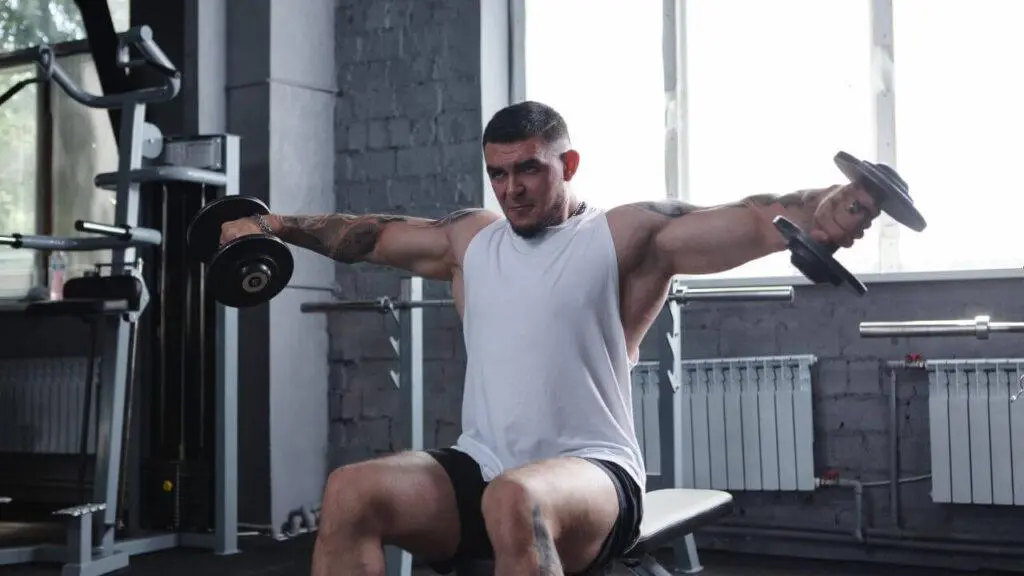For working out and building strength, there are many different types of exercises accessible. Whether it’s strength development, muscular growth, or functional motions, both compound and isolation exercises offer special advantages and may be used in a training regimen to meet certain objectives.
Table of Contents
ToggleIt might be easier to maximize your results and more quickly meet your fitness objectives if you know the distinctions between compound vs isolation exercises and how to include them in your regimen.
However, what are these exercises specifically and how are they distinct from one another? This article will go into the realm of compound and isolation exercises, examining what they are, their advantages, and the best ways to include them in your training program.
Start Building Your Dream Body Today
Ready to elevate your fitness game without falling into the trap of dull, repetitive routines that just don’t deliver? Imagine sculpting your ideal physique and boosting your health, all while still enjoying life’s pleasures, like those irresistible weekend getaways and your aunt’s legendary cheesecake. With our online fitness and nutrition coaching service, you don’t have to compromise. Dive into a personalized fitness journey that blends perfectly with your lifestyle, not against it. Book your completely free discovery consultation today, and take the first step towards a transformation that doesn’t require giving up the joys of life.

“I was skeptical about online fitness coaching, but Functional Body Savage completely changed my perspective. Vanja and Radomir’s personalized approach and attention to detail have helped me achieve goals I never thought possible. I’m stronger, more confident, and grateful for their guidance.”
Emily Thompson, San Francisco, CA
Learn More About Our Online Coaching ServiceQuick Summary
- While isolation exercises concentrate on a single joint or muscle group, compound exercises use many joints and muscle groups.
- Compound exercises are helpful for increasing general strength and muscular development, while isolation exercises serve to hone and define specific muscle groups.
- Mixing both compound and isolation exercises into your workout routine can give you a balanced, well-rounded physique and increase in muscle hypertrophy.
- Perform all compound exercises first, followed by isolation exercises, or try alternating them to avoid boredom and stay motivated.
What Are Compound Exercises?
Compound exercises are exercises that engage many joints and multiple muscle groups simultaneously. They are supposed to be performed first in a workout since they are often more demanding and take more energy and effort.
Bench presses, squats, pull-ups, deadlifts, and other exercises are examples of the best compound exercises. These exercises are fantastic for building muscle and enhancing general strength and everyday functional mobility by targeting multiple joint movements.
Compound exercises are excellent for more muscle growth, overall muscle development, and targeting multiple joints at once. They are the best for muscle-building programs since compound exercises require you to lift heavier loads to be the most effective.
“Compound movements (deadlift, squat, bench press) use more muscles in unison, yes. Compound movements also more closely resemble the way we move naturally and the ‘7 primal movements.” – Adam Sinicki, AKA The Bioneer, author of the Functional Fitness and Beyond
What Are Isolation Exercises?
Isolation exercises are exercises that target a specific muscle group without engaging other muscle groups. You may focus your attention on that area since they limit the movement to a single joint or muscle group.
This kind of exercise is beneficial for improving general muscular endurance as well as muscle definition and shape. Bicep curls, triceps extensions, calf raises, leg extensions, and lateral raises are a few examples of isolated exercises. Since the aim of these exercises is to exhaust specific muscles, smaller weights, and greater repetitions are often used. To prevent injury, they should still be performed with good form [1].
Compound vs Isolation Exercises: The Similarities
Compound and isolation exercises may seem vastly different, but they do have some similarities:
- Build strength: Compound movements and isolation exercises can both help you gain more overall strength and muscle mass.
- Improve fitness: Compound and isolation exercises can both help you get fitter overall and perform better in sports.
- Require good form: It’s essential to do both types of exercises with proper form in order to prevent injuries, and ensure that the targeted muscles are being worked effectively.
- Usage in resistance training: Compound movement and isolation exercises can both be utilized in resistance training to develop muscular mass, strength, and athletic performance.
Finding the ideal balance and mix that works best for your objectives and capabilities is the key to success. Both compound and isolation exercises have significant roles to play in a well-rounded training regimen.
Compound vs Isolation Exercises: The Differences
Compound and isolation exercises differ in several key ways, each affecting the way they should be used and their effectiveness in a workout routine:
- Targeted muscle groups: Compound exercises work a variety of joints and muscle groups, working the entire body and enhancing functional motions. On the other hand, isolation exercises target a single joint and a single muscle group, allowing for more attention on that muscle and better definition.
- Strengthening: Because compound exercises use more muscle groups and higher weights, they are often superior at enhancing overall strength. Isolation exercises that target imbalances and limitations in certain muscle groups are superior at enhancing muscular definition.
- Time efficiency: Because compound exercises target many muscle groups in a single motion, a full-body workout may be completed in less time. Exercises that isolate one muscle group and require several sets and repetitions to get effects might take longer to complete.
- Training goals: While isolation movements are better for enhancing muscle definition, focusing on imbalances and weaknesses, and rehabilitation, compound exercises are often superior for gaining mass, power, and overall strength.
- Equipment: While isolation exercises may frequently be performed with just body weight or minimum equipment, compound exercises generally require additional equipment and space.
Compound exercises should make up the majority of your training if you want to achieve a thorough, effective, and functional workout. However, there are circumstances in which it is essential and advised to isolate a particular muscle, muscle group, or joint.
Compound Exercise vs Isolation Exercise for Hypertrophy
Hypertrophy is the process of increasing the size of muscle fibers through resistance training. Activities that promote hypertrophy include both compound and isolation exercises, however, the strategy and techniques may differ.
Squats and deadlifts are examples of compound exercises that are excellent for developing overall mass and strength because they may train the entire body and trigger the production of hormones like testosterone that aid in muscle growth.
Targeting certain muscle parts and enhancing muscle definition using isolation exercises, such as bicep curls and triceps extensions, can increase time under strain and encourage hypertrophy.
Finding the ideal mix between complex and isolation exercises is crucial for hypertrophy and developing other muscles. The best results for hypertrophy come from a training regimen that combines both kinds of exercises.
It’s also critical to keep in mind that encouraging hypertrophy requires progressive loading, or progressively increasing the weight employed. Progressive overload should be included in a training regimen to keep the muscles challenged and achieve benefits, regardless of whether it predominantly comprises compound or isolation exercises.

Benefits of Compound Exercises
Every training regimen must include compound exercises since they provide so many advantages for both novice and expert fitness lovers. Compound exercises provide a number of important advantages, including:
- Strength and muscle mass gains: Greater strength and muscle mass increases are the result of compound exercises, which engage more muscle fibers and give the body a bigger total stimulus for muscle growth.
- Full-body workout: Compound exercises utilize many joints and muscle groups at once, working the entire body in a single motion. This can speed up functional movements and reduce time spent on them, making daily tasks simpler.
- Better core stability: Strength and core stability are increased as a result of the involvement of the core muscles during several compound exercises like squats and deadlifts.
- Improved calorie burn: Because compound exercises use many muscle groups and increase total energy expenditure, they tend to burn more calories than isolation exercises [2].
- Improved functional fitness: Compound exercises simulate real-life motions and activities, promoting athletic performance and improving functional fitness.
- Better hormonal reaction: It has been demonstrated that compound exercises increase the release of hormones including growth hormone and testosterone, which can support muscular growth and general health [3].
Generally, compound exercises are an excellent tool for increasing overall fitness and sports performance.
Benefits of Isolation Exercises
Any training plan should include isolation exercises since they have several advantages for both novice and expert fitness lovers. The following are some of the main advantages of isolation exercises:
- Targeted muscle development: By focusing more on a single muscular group during isolation exercises, you can improve muscle definition and growth in particular areas.
- Improved mind-muscle connection: By allowing for a greater concentration on a single muscle group, isolation exercises help to strengthen the mind-muscle connection and enable more precise targeting of muscle fibers [4].
- Better range of motion: By enabling a wider range of motion, isolation exercises can assist increase joint flexibility and mobility.
- Reduced risk of injury: Compared to compound exercises, which include many joints and muscle groups, isolation exercises, which isolate just one muscle group, can lower the risk of injury.
- Help in rehabilitation: Exercises that isolate and strengthen particular muscle groups can be utilized in rehabilitation to assist people to recover from injuries [5].
Overall, isolation exercises are a valuable tool for targeted training and improved muscle development.
Common Compound Exercises for Different Muscle Groups
You can include the following typical compound exercises for different muscle groups in your fitness regimen:
Squats
Squats are a fantastic compound exercise for general lower body strength since they target numerous muscular groups, including the quadriceps, hamstrings, glutes, and lower back.
Deadlifts
A compound exercise that works the glutes, back, and legs. They are a great exercise for enhancing overall strength and power because they target the biggest muscle groups in the body.
Bench Press
The bench press works the chest, shoulders, and triceps. It is a compound exercise, and popular weightlifting and bodybuilding exercise that is good for developing upper body strength.
Pull-Ups
Pull-ups are a compound exercise that strengthens the shoulders, biceps, and back. Although difficult, they are useful for developing upper body strength and definition.
Bent-Over Rows
Bent-over rows are a compound exercise that strengthens the shoulders, biceps, and back. For developing general upper body strength and definition, they are an excellent choice.
Dips
Compound exercises like dips work the triceps, chest, and shoulders. They are an efficient upper body exercise for developing strength and definition.
Overhead Press
A compound exercise known as the overhead press targets the shoulders, triceps, and upper back. It is a useful exercise for boosting total upper body strength and muscular growth since it engages several muscle groups simultaneously.
Common Isolation Exercises for Different Muscle Groups
You can include the following typical isolation exercises for different muscle groups in your fitness regimen:
Bicep Curls
A common isolation exercise that targets the biceps muscle in the upper arm is the bicep curl. Free weights like dumbbells or barbells are frequently used when performing bicep curls.
Tricep Extensions
An isolation exercise for the triceps muscle in the upper arm is called a tricep extension. Resistance machines or free weights like dumbbells or barbells can be used to do tricep extensions.
Leg Extensions
An isolation exercise known as leg extensions targets the quadriceps muscle at the front of the thigh. On a resistance machine, leg extensions are commonly practiced.
Hamstring Curls
Exercises called hamstring curls isolate the hamstrings, a muscle near the rear of the leg. You may do hamstring curls with free weights or a resistance machine.
Lateral Raises
Exercises called lateral rises isolate the lateral deltoids, which are the shoulder muscles. Typically, free weights like dumbbells are used for lateral lifts.
Flyes
Flyes are an isolation exercise for the pectoralis major, which is a muscle in the chest. Use free weights like dumbbells or resistance machines to do flyes.
Calf Raises
An exercise called “calf raises” isolates and strengthens the calf muscles in the lower leg. With or without additional resistance, such as weights or resistance machines, calf raises can be performed.
Implementing Compound and Isolation Exercises Into Same Workout
Both compound and isolation exercises are beneficial for general fitness and strength training, but they perform distinct functions and deliver different benefits. To get the most out of a workout, combine both sorts of activities into a well-rounded fitness plan. Here are some pointers for incorporating compound and isolation exercises within the same workout:
- Compound exercises first: Compound exercises should be performed first in a workout since they frequently demand more energy and engage numerous muscle groups, which makes them excellent body warm-up.
- Isolation exercises later: Perform isolation exercises after finishing compound exercises. After a solid workout from the compound exercises, this enables you to target certain muscle areas with increased attention and intensity.
- Alternating: Switching between compound and isolation exercises keeps the body engaged and prevents monotony. For instance, a fantastic technique to include both types of exercises in a workout is to perform three sets of compound exercises followed by three sets of isolation exercises.
Follow the proper order of exercise to maximize the effects of your workouts.
Related Articles:
- 31 Functional Exercises for Superior Strength and Mobility
- Functional Training 101: Ultimate Guide to Next-Level Fitness
- What Is the Hardest Compound Exercise?
FAQs
Are Isolation Exercises Better Than Compound?
No, isolation exercises are not better than compound exercises. It’s preferable to use compound exercises to build good overall strength before attempting isolation exercises.
Should I Do Compound or Isolation First?
You should do compound exercises first, as a general guideline, and then move on to isolation exercises.
What Builds More Muscle Compound or Isolation?
Compound exercises build more muscle. This is because the more muscle groups are worked, the possibility of increasing total strength improves.
Are Compound or Isolation Exercises Better for Bulking?
Compound exercises are better for bulking. They increase the number of muscle groups stimulated and lower the chance of losing muscular symmetry, which can happen when concentrating too much on a single muscle group.
Are Compound or Isolation Exercises Better for Hypertrophy?
Compound exercises are better for hypertrophy. They help lift heavier weights, involve more muscle groups, and are time efficient.
Why Are Both Compound and Isolation Exercises Important?
Both compound and isolation exercises are important because of their own unique benefits. Different fitness objectives may be met with both forms of training, from enhancing flexibility and balance to strengthening and bulking up the muscles.
It all comes down to balance and variation when it comes to the significance of compound and isolation exercises. Including both kinds of exercises in your workout program may help you make sure you’re working every muscle group and achieving a well-rounded body. Exercise variety can also help you stay motivated and avoid boredom, which is important for long-term success.
The most effective method for your workout will ultimately rely on your own objectives and level of fitness. If you are aware of the similarities and differences between compound and isolation exercises, you may decide how to mix both into your workout program to meet your fitness objectives.
Start Building Your Dream Body Today
Ready to elevate your fitness game without falling into the trap of dull, repetitive routines that just don’t deliver? Imagine sculpting your ideal physique and boosting your health, all while still enjoying life’s pleasures, like those irresistible weekend getaways and your aunt’s legendary cheesecake. With our online fitness and nutrition coaching service, you don’t have to compromise. Dive into a personalized fitness journey that blends perfectly with your lifestyle, not against it. Book your completely free discovery consultation today, and take the first step towards a transformation that doesn’t require giving up the joys of life.

“I was skeptical about online fitness coaching, but Functional Body Savage completely changed my perspective. Vanja and Radomir’s personalized approach and attention to detail have helped me achieve goals I never thought possible. I’m stronger, more confident, and grateful for their guidance.”
Emily Thompson, San Francisco, CA
Learn More About Our Online Coaching ServiceReferences:
- https://www.mdpi.com/2075-4663/6/4/160
- https://www.sciencedaily.com/releases/2021/09/210922121905.htm
- https://www.menstclinic.com/blog/can-exercise-increase-your-testosterone
- https://pubmed.ncbi.nlm.nih.gov/28500415/
- https://www.mdpi.com/2227-9032/9/10/1397/htm





